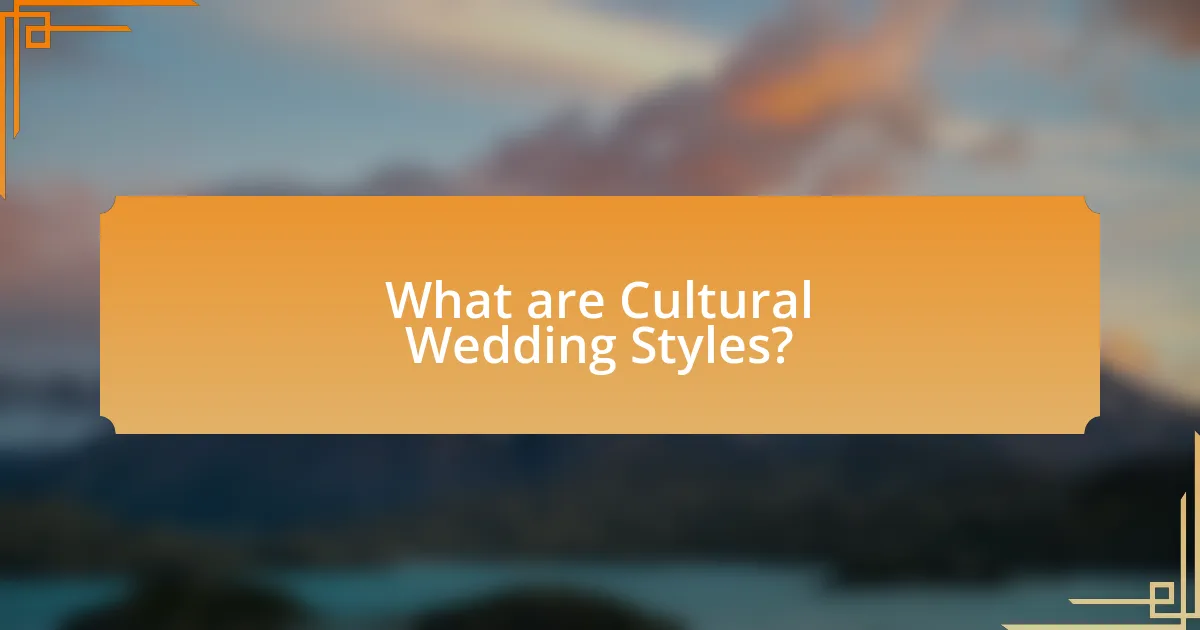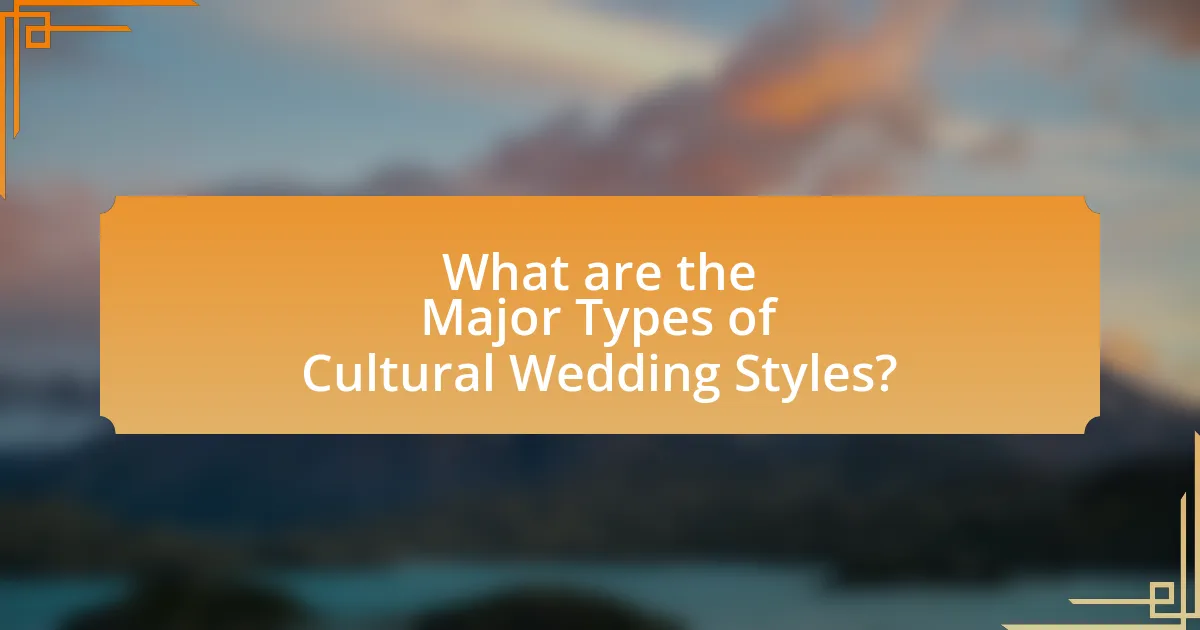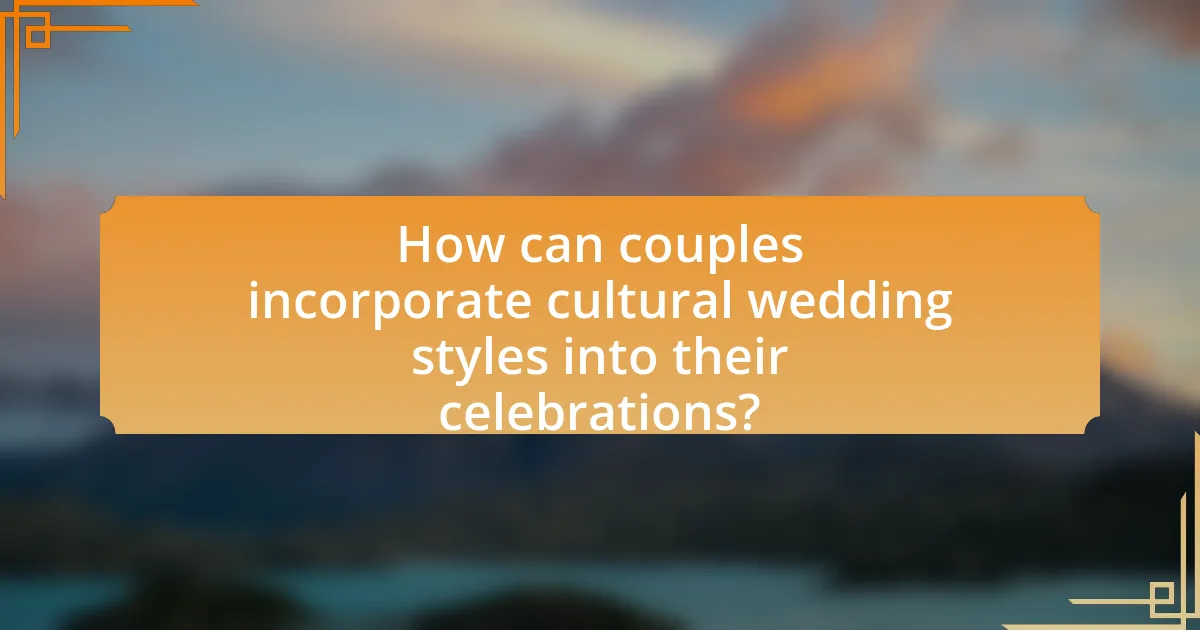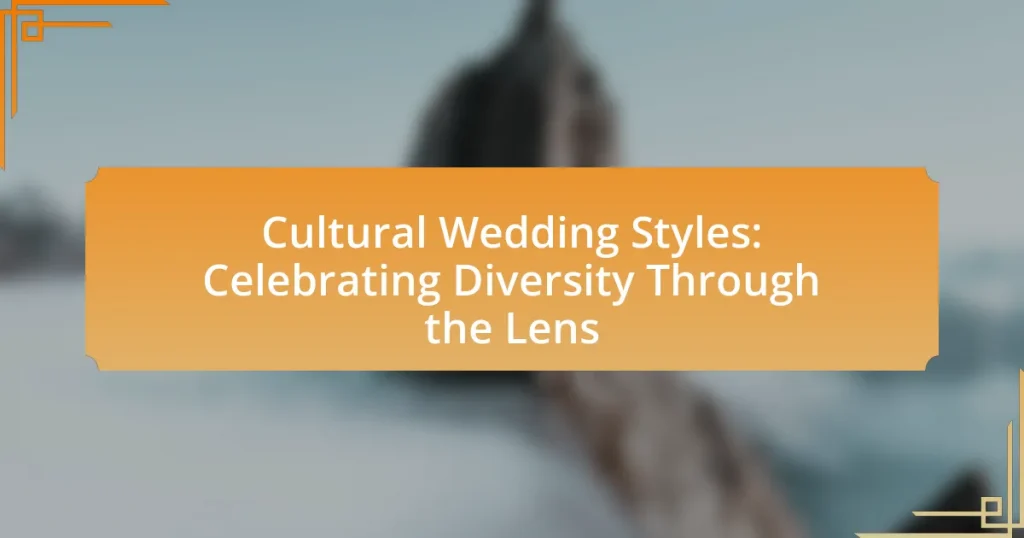Cultural wedding styles encompass the diverse traditions and practices that reflect the values and customs of specific cultures during marriage ceremonies. This article explores how these styles vary across regions, highlighting elements such as attire, rituals, and culinary practices that define them. It examines the societal values reflected in wedding customs, the significance of symbols, and the importance of celebrating diversity in wedding styles. Additionally, the article discusses how couples can incorporate cultural elements into their celebrations, the role of wedding planners, and best practices for honoring cultural diversity in weddings.

What are Cultural Wedding Styles?
Cultural wedding styles are distinct traditions and practices that reflect the values, beliefs, and customs of specific cultures during the marriage ceremony. These styles can vary significantly across different regions and communities, showcasing unique elements such as attire, rituals, and ceremonies. For example, Indian weddings often feature vibrant colors, intricate henna designs, and multiple days of celebration, while traditional Japanese weddings may include Shinto rituals and the wearing of kimonos. The diversity in cultural wedding styles highlights the rich tapestry of human experiences and the importance of cultural heritage in the celebration of marriage.
How do cultural wedding styles reflect societal values?
Cultural wedding styles reflect societal values by embodying the traditions, beliefs, and social norms of a community. For instance, in many cultures, weddings serve as a public declaration of commitment, reinforcing the importance of family and community ties. In Hindu weddings, rituals such as the Saptapadi, where the couple takes seven steps together, symbolize their commitment to each other and their families, highlighting the value placed on familial bonds and collective responsibility. Similarly, in Western cultures, the exchange of vows and rings signifies personal commitment and individual choice, reflecting values of love and autonomy. These practices illustrate how wedding customs are not merely personal celebrations but also serve as a mirror to the broader societal values that shape relationships and community structures.
What elements define cultural wedding styles across different regions?
Cultural wedding styles across different regions are defined by elements such as traditions, rituals, attire, and culinary practices. For instance, in Indian weddings, vibrant colors, intricate henna designs, and rituals like the Saptapadi (seven steps) are prominent, reflecting the cultural significance of marriage in Hindu society. In contrast, Western weddings often emphasize white bridal gowns and the exchange of vows in a church setting, symbolizing purity and commitment. Additionally, regional variations, such as the use of specific flowers or music, further distinguish wedding styles; for example, traditional African weddings may incorporate drumming and dancing as integral parts of the celebration. These elements collectively illustrate the rich tapestry of cultural diversity in wedding practices worldwide.
How do traditions influence the choice of wedding styles?
Traditions significantly influence the choice of wedding styles by dictating the customs, rituals, and attire that are deemed appropriate for the ceremony. For instance, in many cultures, specific rituals such as the exchange of vows, the presence of certain symbols, or the performance of traditional dances are integral to the wedding experience. In India, for example, the use of vibrant colors and elaborate ceremonies reflects cultural heritage, while in Western cultures, white dresses and formal receptions are common, rooted in historical practices. These traditions shape not only the aesthetic elements of the wedding but also the overall structure and significance of the event, ensuring that the celebration aligns with cultural values and familial expectations.
Why is it important to celebrate diversity in wedding styles?
Celebrating diversity in wedding styles is important because it acknowledges and honors the unique cultural traditions and values that shape individual identities. This recognition fosters inclusivity and respect among different communities, allowing couples to express their heritage and personal stories through their wedding ceremonies. For instance, a study by the Pew Research Center highlights that multicultural weddings can enhance social cohesion by bridging cultural gaps and promoting understanding among diverse groups. By embracing various wedding styles, society not only enriches the wedding experience but also strengthens communal bonds and appreciation for cultural differences.
What role does cultural representation play in weddings?
Cultural representation plays a crucial role in weddings by reflecting the diverse traditions, values, and identities of the individuals involved. This representation not only honors the couple’s heritage but also fosters inclusivity and understanding among different cultures. For instance, incorporating specific rituals, attire, and customs from various cultures can enhance the wedding experience, making it more meaningful and personalized. Studies show that multicultural weddings can strengthen family bonds and promote cultural awareness, as they often involve blending elements from different backgrounds, thereby enriching the celebration.
How can diverse wedding styles promote inclusivity?
Diverse wedding styles promote inclusivity by allowing individuals from various cultural backgrounds to express their unique traditions and values during the celebration of marriage. This representation fosters a sense of belonging and acceptance among guests, as they witness and participate in a variety of customs that reflect different heritages. For instance, incorporating elements such as attire, rituals, and cuisine from multiple cultures not only honors those traditions but also encourages dialogue and understanding among attendees. Studies have shown that multicultural events can enhance social cohesion and reduce cultural barriers, making weddings a powerful platform for inclusivity.

What are the Major Types of Cultural Wedding Styles?
The major types of cultural wedding styles include traditional, religious, and modern weddings, each reflecting unique cultural practices and beliefs. Traditional weddings often incorporate customs specific to a particular culture, such as attire, rituals, and ceremonies that have been passed down through generations. Religious weddings are characterized by ceremonies that adhere to the doctrines and practices of a specific faith, such as Christian, Hindu, or Islamic weddings, which often include sacred rituals and prayers. Modern weddings may blend various cultural elements or adopt contemporary trends, focusing on personalization and individual expression. These distinctions highlight the diversity in wedding celebrations across different cultures, showcasing how cultural heritage influences the way couples unite.
How do traditional weddings differ from modern interpretations?
Traditional weddings typically emphasize cultural rituals, family involvement, and established customs, while modern interpretations often prioritize personal choice, individual expression, and simplified ceremonies. Traditional weddings may include specific attire, religious ceremonies, and community participation, reflecting the values and heritage of the couple’s background. In contrast, modern weddings frequently incorporate contemporary themes, non-traditional venues, and personalized vows, allowing couples to tailor their ceremonies to their unique preferences. This shift is supported by trends indicating that over 50% of couples now opt for personalized elements in their weddings, moving away from rigid traditions.
What are the key features of traditional weddings in various cultures?
Traditional weddings across various cultures exhibit key features that reflect their unique customs and beliefs. Common elements include rituals, attire, and symbolic practices. For instance, in Hindu weddings, the Saptapadi ritual involves the couple taking seven steps together, symbolizing their union. In Western cultures, the exchange of vows and rings signifies commitment. Additionally, traditional attire varies significantly; for example, brides in Chinese weddings often wear red dresses, symbolizing good fortune, while in Middle Eastern cultures, elaborate henna designs are applied to the bride’s hands as part of the celebration. These features not only highlight the cultural significance of marriage but also reinforce community bonds and shared values.
How have modern influences reshaped traditional wedding practices?
Modern influences have significantly reshaped traditional wedding practices by introducing diverse cultural elements, technology, and personalized experiences. For instance, many couples now incorporate non-traditional venues, such as beaches or parks, instead of religious or formal settings, reflecting a shift towards personalization and individual expression. Additionally, the use of social media platforms for sharing wedding moments has transformed how weddings are planned and celebrated, allowing for broader participation and engagement from friends and family, regardless of location. This evolution is supported by data indicating that over 70% of couples use social media for wedding inspiration, showcasing the impact of modern trends on traditional customs.
What unique elements are found in specific cultural weddings?
Unique elements in specific cultural weddings include distinct rituals, attire, and symbolism that reflect the values and traditions of each culture. For example, in Hindu weddings, the Saptapadi ritual involves the couple taking seven steps together, symbolizing their journey through life. In Jewish weddings, the breaking of the glass signifies the fragility of relationships and the destruction of the Temple in Jerusalem, emphasizing the importance of commitment. Additionally, in Chinese weddings, the color red is prominently featured as it symbolizes good fortune and happiness, while the tea ceremony represents respect for family and ancestors. These elements are integral to the cultural identity and heritage of the communities involved, showcasing the diversity of wedding traditions worldwide.
How do rituals and customs vary among different cultures?
Rituals and customs vary significantly among different cultures, reflecting unique historical, social, and religious contexts. For instance, wedding ceremonies differ widely; in Hindu culture, the wedding includes rituals like the Saptapadi, where the couple takes seven steps together, symbolizing their union, while in Western cultures, a common practice is the exchange of vows and rings. Additionally, cultural variations can be seen in the significance of food, attire, and the role of family during these events, such as the traditional Chinese tea ceremony, which honors ancestors and family lineage. These differences illustrate how cultural identity shapes the practices and meanings associated with rituals and customs.
What significance do symbols hold in various wedding ceremonies?
Symbols in various wedding ceremonies hold significant cultural and emotional meanings, representing values, beliefs, and traditions unique to each community. For instance, in many Western cultures, the wedding ring symbolizes eternal love and commitment, while in Hindu weddings, the mangalsutra signifies the bond between husband and wife, reflecting the importance of marital fidelity. Additionally, the use of specific colors, such as red in Chinese weddings, symbolizes good fortune and happiness. These symbols serve not only as visual representations of the couple’s vows but also as a means to connect with cultural heritage, reinforcing the social fabric of the community.

How can couples incorporate cultural wedding styles into their celebrations?
Couples can incorporate cultural wedding styles into their celebrations by integrating traditional elements from their respective heritages, such as attire, rituals, and cuisine. For instance, wearing traditional garments like a kimono for Japanese weddings or a lehenga for Indian ceremonies can enhance the cultural significance of the event. Additionally, couples can include specific rituals, such as the tea ceremony in Chinese weddings or the breaking of the glass in Jewish weddings, which symbolize important cultural values and beliefs. Furthermore, serving traditional dishes that reflect their backgrounds, such as paella for Spanish heritage or jerk chicken for Jamaican culture, can create a culturally rich dining experience. These practices not only honor the couple’s backgrounds but also educate guests about diverse cultural traditions, fostering a deeper appreciation for multiculturalism in weddings.
What are some tips for blending different cultural traditions?
To blend different cultural traditions effectively, prioritize open communication and mutual respect among all parties involved. Engaging in discussions about each tradition’s significance fosters understanding and allows for the selection of elements that resonate with everyone. Research indicates that weddings incorporating diverse cultural practices can enhance the experience for guests and participants, creating a richer celebration. For instance, a study published in the Journal of Cross-Cultural Psychology highlights that couples who honor both backgrounds often report higher satisfaction levels in their marriage.
How can couples honor their heritage while embracing new customs?
Couples can honor their heritage while embracing new customs by integrating traditional elements into modern practices during their celebrations. For instance, they can incorporate cultural rituals, such as specific ceremonies or attire, alongside contemporary themes or styles that reflect their personal values and experiences. This approach not only preserves their cultural identity but also allows for the creation of a unique blend that resonates with both their backgrounds and their current lives. Research indicates that multicultural weddings, which combine diverse traditions, are increasingly popular, reflecting a growing acceptance and appreciation of cultural diversity in society.
What practical considerations should couples keep in mind when planning a culturally diverse wedding?
Couples planning a culturally diverse wedding should prioritize inclusivity, communication, and cultural representation. Inclusivity ensures that all traditions and customs from both cultures are acknowledged and respected, which can be achieved by involving family members from both sides in the planning process. Effective communication between partners about their cultural expectations and preferences is crucial to avoid misunderstandings. Additionally, cultural representation can be reflected in various aspects of the wedding, such as attire, rituals, and cuisine, ensuring that both cultures are authentically celebrated. For instance, incorporating traditional ceremonies from each culture can enhance the wedding’s significance and create a more meaningful experience for all attendees.
What resources are available for exploring cultural wedding styles?
Resources for exploring cultural wedding styles include books, online platforms, and cultural organizations. Books such as “The Wedding Book: The Big Book for Your Big Day” by Mindy Weiss provide insights into various cultural traditions. Online platforms like Pinterest and Instagram offer visual inspiration and examples of diverse wedding styles from around the world. Additionally, cultural organizations often host events and workshops that showcase traditional wedding practices, allowing individuals to experience and learn about different cultural customs firsthand. These resources collectively enhance understanding and appreciation of the rich diversity in wedding styles globally.
How can couples find inspiration for their cultural wedding themes?
Couples can find inspiration for their cultural wedding themes by exploring their heritage, traditions, and family histories. Engaging with cultural elements such as traditional attire, rituals, and cuisine can provide a rich foundation for the wedding theme. Research indicates that incorporating personal and familial cultural backgrounds enhances the authenticity of the celebration, as seen in studies highlighting the significance of cultural identity in wedding planning. Additionally, couples can seek inspiration from cultural festivals, art, and literature that resonate with their backgrounds, further enriching their wedding experience.
What role do wedding planners play in facilitating cultural weddings?
Wedding planners play a crucial role in facilitating cultural weddings by ensuring that traditional customs and rituals are accurately represented and seamlessly integrated into the wedding experience. They possess specialized knowledge of various cultural practices, which allows them to guide couples in selecting appropriate elements such as attire, ceremonies, and food that reflect their heritage. For instance, a wedding planner familiar with Indian weddings can coordinate intricate rituals like the Mehndi ceremony and the Saptapadi, ensuring that these significant traditions are honored. Additionally, wedding planners manage logistics, vendor coordination, and timelines, which alleviates stress for couples and their families, allowing them to focus on the cultural significance of the event. Their expertise not only enhances the authenticity of the celebration but also fosters an inclusive environment that respects and showcases diverse cultural backgrounds.
What are the best practices for celebrating cultural diversity in weddings?
The best practices for celebrating cultural diversity in weddings include incorporating traditions from both families, selecting a diverse menu that reflects various cultures, and including multicultural music and dance. By blending these elements, couples honor their heritage and create an inclusive atmosphere. For instance, a study by the Pew Research Center highlights that 17% of newlyweds in the U.S. are intermarried, showcasing the importance of cultural integration in modern weddings. Additionally, using bilingual invitations and programs can enhance accessibility and respect for different languages, further promoting cultural appreciation.



